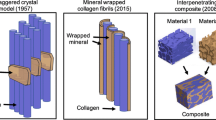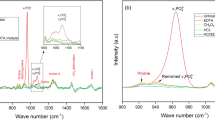Abstract
It is well known that osteoid, which contains a noncalcified collagenous matrix, is formed during the initial stage of bone formation during the bone remodeling process. Thus, synthesis of defective collagen molecules in osteoid may cause abnormal bone formation, thereby leading to changes in bone quality. The objective of this study was to investigate age-related changes in noncalcified collagen molecules in osteoid and its likely effects on the mechanical integrity of human cortical bone. Thirty human cadaveric femurs were divided into three age groups: young adults, middle age, and the elderly, respectively. A novel high performance liquid chromatography approach was employed to quantify the denaturation of noncalcified collagenous matrix in addition to mechanical tests of bone. Bulk concentrations of both enzymatic and nonenzymatic collagen cross links in bone also were measured. Moreover, the number of newly formed osteons per unit area and the bony area fraction of these osteons were estimated. The results of this study indicate that denaturation of the noncalcified collagenous matrix in bone increases with increasing age. In addition, such collagen denaturation in osteoid exhibited a correlation with nonenzymatic collagen cross links as well as the strength and toughness of bone. These results suggest that age-related changes in the noncalcified collagenous matrix induced by bone remodeling may have likely effects on bone quality. © 2003 Biomedical Engineering Society.
PAC2003: 8719Rr, 8718La, 8280Bg
Similar content being viewed by others
References
ASTM Standard and D790–86. Standard test methods for flexural properties of unreiniforced and reinforced plastics and electrical insulating materials. Philadelphia, PA: American Society for Testing and Materials, 1986.
ASTM Standard and E399–90. Standard test method for plane strain fracture toughness of metallic materials. Philadelphia, PA: American Society for Testing and Materials, 1993.
Bank, R. A., B. Beekman, N. Verzijl, J. A. de Roos, A. N. Sakkee, and J. M. TeKoppele. Sensitive fluorimetric quantitation of pyridinium and pentosidine cross links in biological samples in a single high-performance liquid chromatographic run. J. Chromatogr., B: Biomed. Sci. Appl. 1–2:37–44, 1997.
Bank, R. A., M. Krikken, B. Beekman, R. Stoop, A. Maroudas, F. P. Lafeber, and J. M. te Koppele. A simplified measurement of degraded collagen in tissues: Application in healthy, fibrillated, and osteoarthritic cartilage. Matrix Biol. 5:233–243, 1997.
Buckwalter, J. A., and R. R. Cooper. Bone structure and function. Instructional Course Lecture, 1987, pp. 27–48.
Carter, D. R., and W. C. Hayes. The compressive behavior of bone as a two-phase porous structure. J. Bone Jt. Surg., Am. Vol. 7:954–962, 1977.
Currey, J. D. Effects of differences in mineralization on the mechanical properties of bone. Philos. Trans. R. Soc. London, Ser. B 1121:509–518, 1984.
Frost, H. M. The pathomechanics of osteoporoses. Clin. Orthop. Relat. Res. 200:198–225, 1985.
Ingram, R. T., M. Collazo-Clavell, R. Tiegs, and L. A. Fitzpatrick. Paget's disease is associated with changes in the immunohistochemical distribution of noncollagenous matrix proteins in bone. J. Clin. Endocrinol. Metab. 5:1810–1820, 1996.
Jee, W. S. S. Integrated bone tissue physiology: Anatomy and physiology. In: Bone Mechanics, edited by S. C. Cowin. New York: CRC, 2001, pp. 1–1–68.
Jepsen, K. J., M. B. Schaffler, J. L. Kuhn, R. W. Goulet, J. Bonadio, and S. A. Goldstein. Type I collagen mutation alters the strength and fatigue behavior of Mov 13 cortical tissue. J. Biomech. 11–12:1141–1147, 1997.
Katz, J. L. Anisotropy of Young's modulus of bone. Nature (London) 5742:106–107, 1980.
Katz, J. L., H. S. Yoon, S. Lipson, R. Maharidge, A. Meunier, and P. Christel. The effects of remodeling on the elastic properties of bone. Calcif. Tissue Int. 1:S31–S36, 1984.
Kronick, P. L., and P. Cooke. Thermal stabilization of collagen fibers by calcification. Connect. Tissue Res. 4:275–282, 1996.
Landis, W. J. The strength of a calcified tissue depends in part on the molecular structure and organization of its constituent mineral crystals in their organic matrix. Bone (Osaka) 5:533–544, 1995.
Martin, B. Aging and strength of bone as a structural material. Calcif. Tissue Int. 1:S34–S40, 1993.
Martin, R. B., and D. L. Boardman. The effects of collagen fiber orientation, porosity, density, and mineralization on bovine cortical bone bending properties. J. Biomech. 9:1047–1054, 1993.
Miyata, T., K. Notoya, K. Yoshida, K. Horie, K. Maeda, K. Kurokawa, and S. Taketomi. Advanced glycation end products enhance osteoclast-induced bone resorption in cultured mouse unfractionated bone cells and in rats implanted subcutaneously with devitalized bone particles. J. Am. Soc. Nephrol. 2:260–270, 1997.
Mundy, G. R. New concepts in bone metabolism: Clinical implications. Hosp. Pract. (Off Ed) 1:7–12, 1991.
Nimni, B. S., S. Bernick, W. Paule, and M. E. Nimni. Changes in the ratio of noncalcified collagen to calcified collagen in human vertebrae with advancing age. Connect. Tissue Res. 2:133–140, 1993.
Nyssen-Behets, C., P. Y. Duchesne, and A. Dhem. Structural changes with aging in cortical bone of the human tibia. Gerontology 6:316–25, 1997.
Thompson, D. D. Age changes in bone mineralization, cortical thickness, and Haversian canal area. Calcif. Tissue Int. 1:5–11, 1980.
Wang, X., R. A. Bank, J. M. TeKoppele, and C. M. Agrawal. The role of collagen in determining bone mechanical properties. J. Orthop. Res. 6:1021–1026, 2001.
Wang, X., R. A. Bank, J. M. TeKoppele, G. B. Hubbard, K. A. Athanasiou, and C. M. Agrawal. Effect of collagen denaturation on the toughness of bone. Clin. Orthop. Relat. Res. 371:228–239, 2000.
Zioupos, P., J. D. Currey, and A. J. Hamer. The role of collagen in the declining mechanical properties of aging human cortical bone. J. Biomed. Mater. Res. 2:108–116, 1999.
Author information
Authors and Affiliations
Rights and permissions
About this article
Cite this article
Wang, X., Li, X., Shen, X. et al. Age-Related Changes of Noncalcified Collagen in Human Cortical Bone. Annals of Biomedical Engineering 31, 1365–1371 (2003). https://doi.org/10.1114/1.1623488
Issue Date:
DOI: https://doi.org/10.1114/1.1623488




